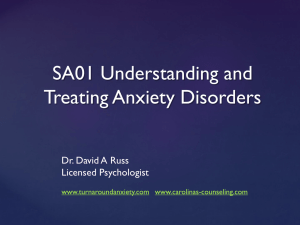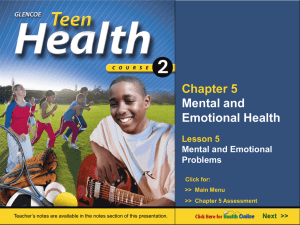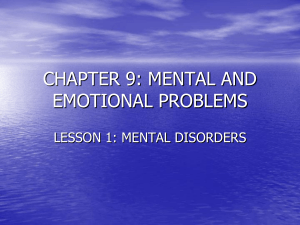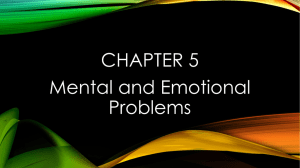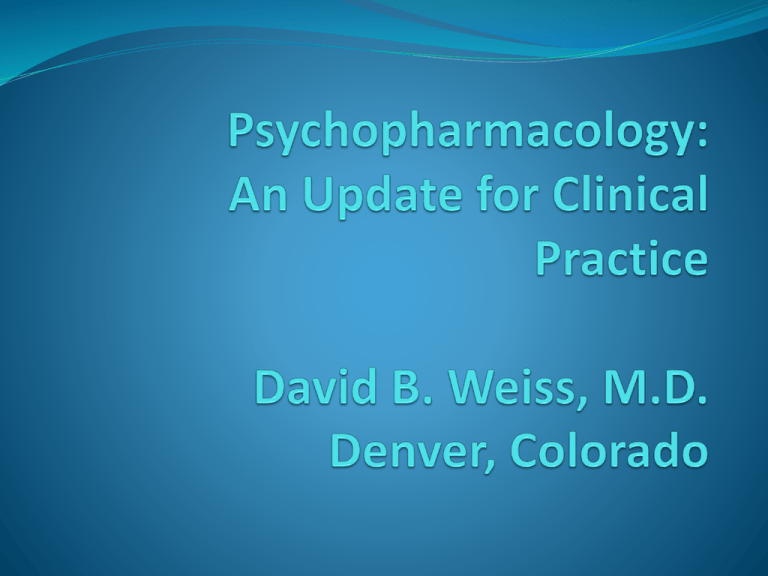
Disclosures
Speaker’s Bureau: Otsuka and Lundbeck
Off-Label Uses Will Be Discussed
Objectives
Review Common Psychiatric Diagnoses
presenting in the primary care setting
Review available pharmacologic
treatment options
Depressive Disorders
History
Prevalence: 15% total, 25% woman
Cost: estimate $45-55 Billion annually in U.S.
Treatment: 2/3 of people with depression do not
realize they have it (Andrew, 3/2012) and only 20% of
those diagnosed received appropriate treatment
Depressive Disorders
Depressed patients lose on average 5-6 hours of
productive work every week
Depressed patients are more than 2 times likely to take
sick days
Depressed patients are 7 times more likely to be
unemployed
Depressive Disorders
Depressed patients have an 11% decrease in the
probability of getting married
Patients have a 35% decrease in lifetime income due to
depression
Rates of undetected depression among drug and
alcohol users are estimated to be at least 30%
Depressive Disorders
According to WHO, depression was the 3rd most
important cause of disease burden worldwide in 2004
A Toronto study showed workers who were treated for
severe depression were 7 times more likely to be high
performing than those who were not
Epidemiology
•
Sex
•
•
Age
•
•
Not differ from race to race
Socioeconomic
•
•
Mean age of onset 40 years old
Race
•
•
Women > Men
No correlation
Marital Status
•
Higher if no close relationships, divorced, separated
Etiology
Cause Unknown
Causative factors divided into biological factors,
genetic factors, and psychosocial factors
Biological Factors
Mood disorders associated with dysregulations of biogenic
amines norepinephrine, serotonin, dopamine
Adrenal Axis: Hypersecretion of cortisol
Thyroid Axis: Abnormal regulation, autoimmune disorder
(10% have antithyroid antibodies)
Growth hormone: Blunted sleep induced stimulation of
growth hormone release
Etiology
Genetic Factors:
Data strongly suggestive of genetic component
Pattern unknown
Family studies
1st degree relatives 2 to 10 times more likely
Adoption studies
Biological children reared in non affected adoptive family
Twin studies
50% in monozygotic twins
Diagnosis
DSM IV-R specific diagnostic criteria
Qualifiers: Severity, Psychotic, Recurrent, Single,
Remission
Significant distress, functional impairment
Not due to direct physiological effects of a substance
Not better accounted for by bereavement
Symptoms not persist > 2 months after loss
Not suicidal, no significant functional impairment
Clinical Features
Depressed Mood: Subjective or observation
Marked decrease interest
Decrease/Increase appetite, weight change
Sleep disturbance
Psychomotor agitation/retardation
Loss of energy
Guilt, worthlessness
Poor concentration, indecisiveness
Recurrent thoughts of death, suicidal thoughts
Differential Diagnosis
Bipolar Disorder
Premenstrual dysphoric
Dysthmia
Disorder
PostPartum Depression
Depression 2nd to General
Medical Condition
Cyclothymia
Schizoaffective Disorder
Schizophrenia
Anxiety Disorders
Personality Disorders
Substance related Disorders
Uncomplicated
Bereavement
Infections
Endocrine Disorders
Neurological Disorders
Neoplasms
Inflammatory Disorders
Course and Prognosis
Course
Chronic and Relapsing course
Untreated: 6-13 months
Treated: 8 weeks – 3 months
20 year period: mean number 5-6 episodes
If hospitalized, 75% recur within 5 years
Prognosis
Poor if: coexisting dysthymic disorder, alcohol abuse,
anxiety disorders, multiple episodes, hospitalization,
men, poor support, personality disorder, late age initial
onset, psychotic component
Treatment
1st Safety
2nd Safety
3rd Safety
First Decision to make
Do you hospitalize the patient?
Voluntary vs. Involuntary
Suicide
15% of depressed people take their own lives
Risk Factors
Male
Elderly
Caucasian
History of previous suicide attepts
Co-Morbid medical illness
Drug/Alcohol use
Co-Morbid psychiatric illness
Social isolation, poor social support
Low job satisfaction, financial stress
Pharmacologic Options
Tricyclics
SSRIs
SNRIs
MAOIs
Other classes
Tricyclic Antidepressants
Common Uses:
Depression*
Neuropathic and Chronic Pain
Headache
Insomnia
Anxiety
OCD* (Clomipramine Anafranil)
Enuresis
Common Tricyclics
Amitriptyline (Elavil)
Nortriptyline (Pamelor)
Imipramine (Tofranil)
Despiramine (Norpramin)
Clomipramine (Anafranil)
Doxepin (Sinequan)
Trimipramine (Surmontil)
Protriptyline (Triptil)
Tricyclic Antidepressants
Mechanism of Action
Block reuptake of norepinephrine
Common Side Effects
Anticholinergic
Dry mouth, constipation, urinary hesitancy
Cardiovascular
Hypotension, palpitations, conduction slowing
CNS
Tremor, sedation, stimulation
Other
Weight gain, sexual, perspiration
Common Drug Drug Interactions
CNS depressants: Sedation
SSRIs: Increase TCA levels
MAOIs: Serotonin Syndrome
Tramadol: Increase Seizure Risk
Antihypertensive drugs: May alter affect
SSRIs
Common Uses:
Depression
Panic Disorder
Generalized Anxiety
PTSD
OCD
Social Anxiety
PMDD
Common SSRIs
Fluoxetine (Prozac)
Paroxetine (Paxil)
Sertraline (Zoloft)
Citalopram (Celexa)
Escitalopram (Lexapro)
Fluvoxamine (Luvox)
SSRIs
Mechanism of Action
Block “Selectively” Serotonin Reuptake
Common Side Effects
GI, CNS activation, sedation, sexual, weight gain, HAs
Common Drug Drug Interaction
TCAs
MAOIs: Serotonin Syndrome
Warfarin, NSAIDs: potential increase risk of bleeding
Tramadol: Increase seizure risk
SNRIs
Common Uses:
Depression*
Generalized Anxiety*
Social Anxiety*
Panic Disorder*
PTSD
PMDD
Chronic Pain*
Fibromyalgia*
Common SNRIs
Venlafaxine (Effexor)
Duloxetine (Cymbalta)
Desvenlafaxine (Pristiq)
SNRIs
Mechanism of Action
Blocks Serotonin and Norepinephrine Reuptake
Common Side Effects
Similar to SSRIs
HTN
Drug Drug Interactions
MAOIs: Serotonin Syndrome
Tramadol: Increase seizure risk
Warfarin, NSAIDs: Potential increase risk of bleeding
MAOIs
Common Uses:
Depression*
Social Anxiety
Panic Disorder
Parkinson’s* (Selegiline)
Dementia
Common MAOIs
Selegiline (EMSAM)
Phenelzine (Nardil)
Tranylcypromine (Parnate)
Isocarboxazid (Marplan)
MAOIs
Mechanism of Action
Blocks MAO from breaking down norepinephrine, serotonin, dopamine
Common Side Effects
Orthostatic hypotension, hypertensive crisis, sexual, sedation, insomnia
Drug Drug Interaction
High Tyramine Foods
SSRIs
SNRIs
TCA
Meperidine
Dextromethorphan
Carbamazepine
Bupropion
Beta-Blockers
Sympathomimetics
“Other”classes and Newer Agents
Bupropion
Mechanism of Action: NDRI
Common Side Effects: headache, insomnia, tremor,
anorexia, seizures (rare)
Drug Drug Interaction: TCA (increase), MAOIs,
Tramadol
“Other” Classes and Newer Agents
Mirtazapine (Remeron)
Mechanism of Action: alpha 2 antagonist, dual serotonin
and norepinephrine agent
Common Side Effects: appetite increase, sedation,
weight gain, dry mouth, hypotension
Drug Drug Interaction: MAOIs, Tramadol
“Other” Classes and Newer Agents
Vilazodone (Viibryd)
Mechanism of Action: Serotonin partial agonist
reuptake inhibitor
Common Side Effects: Nausea, diarrhea, vomiting,
sexual (? Less), brusing
Drug Drug Interactions: MAOIs, Tramadol, SSRIs
(increase levels), Carbamazapine (decrease levels)
“Other” Classes and Newer Agents
Levomilnacipran (Fetzima)
Milnacipran (Savella) FDA approved only for
fibromyalgia
Levomilnacipran is a left isomer of milnacipran
Not approved for treatment of fibromyalgia
Indication: Major Depression
Mechanism of Action: SNRI
Common Side Effects
GI, sexual, sweating, palpitations, hypertension, bruising
“Other Classes and Newer Agents”
Vortioxetine (Brintellix)
Mechanism of Action: SRI (?)
Indication: Major Depression
Common Side Effects: GI, dizziness, sexual, bruising,
Drug Drug Interactions: MAOIs, SSRIs, SNRIs,
Warfarin, NSAIDs
Treatment Strategies Depression
Where to begin?
If it works, what next?
Length
Monitoring
If it doesn’t work, what next?
Dosing
Augment
Switch
Diagnosis
Therapy
Partial Responders/Augmentation
Dose?
Diagnosis?
Medical?
Substance use?
Combination of Antidepressants
Lithium
Thyroid
Stimulants
Atypical Antipsychotics
Buspirone
Treatment Options Beyond
Pharmacotherapy
Psychotherapy
ECT
PhotoTherapy
Magnetic Stimulation
The Good News
Treatment Responsive
Satisfying to Treat
Major Impact on Quality of Patient’s lives, family and
society
Improved Response to Medical Treatment and
Prognosis
Cost Effective Treatment
Anxiety Disorders
Anxiety disorders are the most common class of
mental disorders present in the general population
Affecting 40 million adults in the US in a given year
Only 1/3 suffering receive treatment
Cost $42 billion a year direct/indirect costs
Patients with anxiety disorder 5 times more likely to
access medical care
Anxiety
Excessive Worry
Associated physical symptoms
Avoidant Behavior
Unknown internal source vs. known external source
Sense of dread
Heightened apprehension
Causes of Anxiety
Psychological Theories
Freud: anxiety is a signal to the ego that an unacceptable
drive is pressing for conscious representation
Behavioral Theories
Anxiety is a conditioned response to a specific
environmental stimuli
Biological Theories
Neurotransmitter dysregulation
Anxiety Disorder Sub-Types
Panic Disorder
Generalized Anxiety
Post Traumatic Stress Disorder
Specific Phobias
Social Anxiety Disorder (Social Phobia)
Obsessive Compulsive Disorder
Anxiety Disorder Due to a General Medical Condition
Substance Induced Anxiety Disorder
Anxiety Disorder NOS
Symptoms of Panic Attack
Palpitations
Sweating
Tremor
Shortness of Breath
Chest pain and discomfort
Nausea
Dizziness
Fear of losing control
Fear of dying
Panic Disorder
Recurrent, unexpected panic attacks
Followed by at least one month of:
Persistent concern about having more attacks
Worry about the implications of the attacks
A significant change in behavior related to the attacks
Panic Attack
A discrete period of intense fear or discomfort
associated with multiple physical manifestations
developing abruptly and reaching a peak within 10 min
Panic Disorder
Prevalence: 2% of the population
Sex: 1:2 Male to Female Ratio
Usual onset early adulthood
Attacks usually last a few minutes
Associated symptoms of agoraphobia, depression,
substance abuse
Higher rate of suicide
Marital tension, conflict at work, financial difficulties,
higher rate of accessing medical care
Differential Diagnosis for Panic
Disorder
Medical Disorders
Cardiovascular diseases
Pulmonary diseases
Neurological diseases
Endocrine diseases
Drug intoxications
Drug withdrawal
Mental Disorders
Malingering
Hypochondriasis
Phobias
Post traumatic Stress Disorder
Treatment Panic Disorder
Pharmacotherapy
Tricyclics
SSRIs
Benzodiazepines
Cognitive Behavioral Therapy
Address patient’s false beliefs about panic attack
Relaxation techniques, gaining sense of control
Family Therapy
Insight oriented psychodynamic psychotherapy
Help patient understand the unconscious meaning of the
anxiety
Phobias
Phobia: irrational fear resulting in a conscious
avoidance of the feared object, activity or situation
The single most common mental disorders in the US
10-25% of population are afflicted
Increased risk for other psychiatric complications
including depression and substance abuse
Specific: Fear or avoidance of objects or situations
other than agoraphobia or social phobia
Commonly involves animals, insects, injury or
procedures, heights, darkness
Phobias
Social: Fear of humiliation or embarrassment in either
general or specific social situations
Commonly involving public speaking, urinating in
public restrooms, stage fright
Treatment Phobias
Specific Phobias
Exposure therapy (behavioral therapy)
Insight oriented psychotherapy
Pharmacotherapy (Benzodiazepines, SSRIs)
Social Phobias
Psychotherapy (behavioral, cognitive, insight oriented)
Pharmacotherapy (Beta Blockers, SSRIs,
Benzodiazepines, Buspirone)
Obsessive Compulsive Disorder
Lifetime prevalence: 2-3% of population
4th most common psychiatric disorder
Men = Women
Mean age of onset 20 years old
2/3 of cases onset before age of 25 years old
Can occur in childhood; has been seen in 2 year olds
Single more affected than married
Caucasian > African American (access to healthcare)
Diagnosis
Obsession: A recurrent and intrusive thought, feeling,
idea, or sensation
Compulsion: A conscious, standardized, recurrent
thought or behavior, such as counting, checking, or
avoiding
Obsessions increase a patient’s anxiety
Compulsions decrease a patient’s anxiety
If resist compulsion, anxiety increases
A patient realizes the irrationality of the obsessions
Either obsession or compulsion. Over 75% have both
Treatment OCD
Pharmacotherapy
Clomipramine
SSRIs
Lithium
Benzodiazepines
Psychotherapy
Behavioral therapy (exposure, response and flooding)
Other
ECT
Psychosurgery (cingulotomy)
Post Traumatic Stress Disorder
Experience an emotional stress of potentially life
threatening magnitude that would be traumatic for
almost anyone
Re-experiencing of the trauma through dreams and
waking thoughts
Persistent avoidance of reminders of the trauma
Numbing of responsiveness to such reminders
Persistent hyperarousal
Symptoms greater than a month
Etiololgy
The stressor is the prime causative factor
Predisposing vulnerability include presence of
childhood trauma, personality disorders, poor social
support, genetic vulnerability to psychiatric illness,
recent stressful life change, recent excessive alcohol
use
Treatment PTSD
Pharmacotherapy
SSRIs
Mood Stabilizers
Hypnotics
Anxiolytics
Antipsychotics
Psychotherapy
Supportive
Cognitive
Group
Family
Generalized Anxiety Disorder
An excessive and pervasive worry accompanied by a
variety of somatic symptoms, that cause significant
impairment in social or occupational functioning or
marked distress
A person finds it difficult to control the anxiety
Not due tot eh direct physiological affects of a
substance
Treatment GAD
Pharmacotherapy
Benzodiazepines
Buspirone
Mood Stabilizers
Antipsychotics
SSRIs
SNRIs
TCA
Psychotherapy
Cognitive Behavioral
Insight Oriented
Supportive
Treatment Strategies Anxiety
Where to begin?
If it works, what next?
Length
Monitoring
Therapy
If it doesn’t work, what next?
Dosing
ETOH
Switch
Diagnosis
Therapy
Psychotic Disorders
Schizophrenia
Among top 10 leading cause of disability worldwide in people
15-44 age range WHO
Peak onset young adulthood
All cultures, all ethnic groups, M = W
High Risk of suicide 1/3 attempt
Schizoaffective Disorder
Brief Psychotic Disorder
Schizophreniform Disorder
Delusional Disorder
Shared Psychotic Disorder
Psychotic Disorders Clinical
Features
Delusions
Hallucinations
Disorganized Speech
Disorganized Behavior
Negative Symptoms
Affect blunting
Alogia
Avolition
Differential Diagnosis Psychosis
Bipolar Disorder
Depression
Personality Disorder
Temporal lobe epilepsy
Tumor, Stroke
Infectious Disease
Autoimmune Disorder
Toxic illness
Drug Intoxications
Alcohol withdrawal
Clinical Management
Safety
Pharmacotherapy
Family Therapy
Social Skills Training
Cognitive Rehabilitation
Pharmacotherapy Psychosis
First Generation, Traditional, Neuroleptics, Typical
Antipsychotics
Main Therapeutic Effect by Blocking D2 Receptors
Second Generation, Atypical Antipsychotics
Blocks D1 , D2, 5HT2
Dopamine Pathways
Four Well Defined Dopamine Pathways
Mesolimbic
Mesocortical
Nigrostriatal
DA and Acetylcholine have a reciprocal relationship
Tuberoinfundibular
DA and Prolactin have a reciprocal relationship
Common Typical Antipsychotics
Chlorpromazine (Thorazine)
Haloperidol (Haldol)
Fluphenazine (Prolixin)
Perphenazine (Trilafon)
Thiothixene (Navane)
Trifluoperazine (Stelazine)
Common Atypical Antipsychotics
Aripiprazole (Abilify)
Olanzapine (Zyprexa)
Quetiapine (Seroquel)
Risperidone (Risperdal)
Ziprasidone (Geodon)
Paliperidone (Invega)
Clozapine (Clozaril)
Asenapine (Sapharis)
Lurasidone (Latuda)
Side Effects with AntiPsychotics
Typicals
Neurologic
EPS, Dystonia, Pseudoparkinsonism, akathesia,
Atypicals
Metabolic
Weight gain, Glucose, Lipids,
Tardive Dyskinesia, NMS, Q-T prolongation,
Hyperprolactinemia
Treating EPS
Anticholinergics
Benztropine
Trihexyphenidyl
Antihistaminics
Diphenhydramine
Dopaminergics
Amantadine
Beta-Blockers
Benzodiazepines
Treating EPS
Use lowest possible dose
Move toward a lower potency antipsychotic
Use anticholinergic therapy
Use Amantadine, Benzodiazepine, Beta-Blocker
Consider Atypical
Long Acting Injectable
AntiPsychotics
Typicals
Haloperidol
Fluphenazine
Atypicals
Risperidone
Paliperidone
Olanzapine
Aripiprazole
Thank you !
?’s





